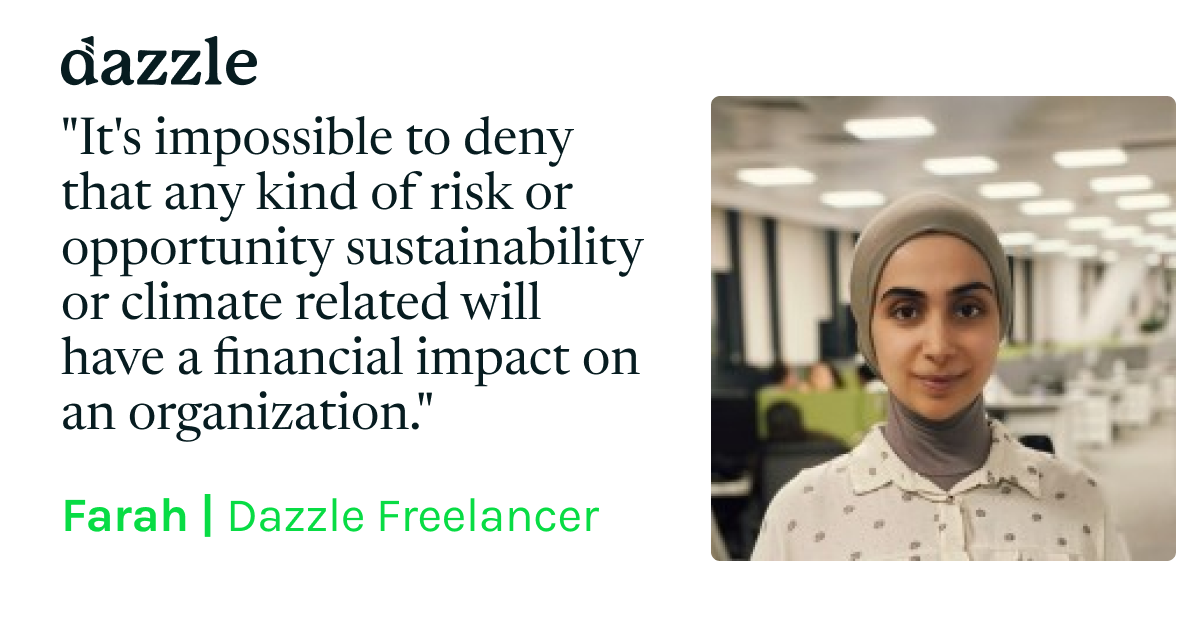Welcome to the intricate world of sustainability reporting — a dynamic field that’s as rich in diversity as it is in acronyms and guidelines.
With the landscape of reporting evolving dramatically in recent years, the International Financial Reporting Standards (IFRS) are at the forefront, steering significant changes from traditional financial disclosures to a deeper focus on environmental accountability.
In this piece, Dazzle freelancer Farah Mammadli, an expert on sustainability reporting, dives deep into the transformative role that the IFRS is playing in reshaping sustainability reporting.
We’re talking about a major shift from the Task Force on Climate-related Financial Disclosures (TCFD) to the birth of the International Sustainability Standards Board (ISSB) under the IFRS umbrella. This change is not just a procedural update; it’s a strategic move toward weaving sustainability into the fabric of financial reporting.
Streamlining With the ISSB
The IFRS has set the stage with the ISSB to craft clear, actionable sustainability-related disclosure standards. This move targets global consistency and simplicity, making it easier for investors and stakeholders to wrap their heads around sustainability-related risks and opportunities.
Through standards like S1 and S2 — focusing on general and climate-related disclosures — the ISSB is crafting a global baseline for data comparison that spans continents and industries.
These standards aim to spotlight the financial implications of sustainability challenges, bridging the gap between environmental impact and fiscal responsibility.
Harmonizing the Field
But why stop at integration?
The push is on to harmonize the assortment of sustainability reporting standards into a single, unified system. This streamlined approach, championed by the likes of the IFRS and supported by frameworks such as the Global Reporting Initiative (GRI), is crucial for crafting a universally usable system.
It’s about making sustainability reporting as routine and understandable as financial reporting — a goal that’s both ambitious and essential.

The Challenges of Diversity
Facing the bewildering ‘alphabet soup’ of sustainability standards is a daunting task for today’s businesses. The mix of frameworks available often leaves companies at a crossroads; uncertain which path will lead them to effective integration into their reporting practices.
Aligning With ISSB and IFRS
Tackling the alignment with the ISSB and the broader IFRS framework presents a formidable set of challenges:
– Complexity of Standards: The varied landscape of standards introduces a layer of complexity to sustainability integration, compelling companies to navigate through a maze of guidelines.
– Financial Quantification: Translating environmental and social impacts into financial terms is a high-stakes puzzle filled with uncertainties, requiring a keen eye for detail and robust financial evaluation.
– Double Materiality Assessments: These assessments require a deep dive into how companies impact and are impacted by external environmental and social factors; a process that demands extensive analysis and comprehensive stakeholder engagement.
Setting Strategic and Governance Frameworks
Strategically embedding sustainability into corporate governance involves several critical steps:
– Strategic Integration: It’s about weaving sustainability into the very core of corporate decision-making.
– Realistic Target Setting: Goals must be clear and achievable, grounded in solid strategies to prevent compliance and accountability pitfalls.
– Mindset Evolution: Companies are urged to see sustainability not just as a regulatory hoop to jump through but as a cornerstone of strategic resilience and long-term growth, especially in sectors like energy, agriculture, and mining where environmental stakes are high.
Spotlight on GRI Standards
The Global Reporting Initiative (GRI) stands out in the sustainability reporting arena, celebrated for its detailed and comprehensive approach to ESG issues.
Its widespread acceptance across diverse industries underscores its utility and effectiveness, despite its voluntary status. The GRI’s contribution to the standardization of the chaotic sustainability reporting landscape is invaluable, paving the way toward a more coherent future.
The Evolutionary Leap from TCFD to ISSB
The expansion from TCFD’s climate-centric financial disclosures to the ISSB’s broader ESG scope represents a significant evolution in sustainability reporting.
This expansion not only enhances transparency and comparability, it also compels businesses to undertake thorough materiality assessments. Thereby identifying and addressing sustainability issues pivotal to their operational and financial health.
Embracing the ISSB Standards
Adopting ISSB standards requires a substantial shift in reporting processes and a strategic business rethink.
Yet, this alignment offers lucrative opportunities by improving stakeholder trust and attracting investments through a demonstrated commitment to comprehensive sustainability practices.
.png)
To conclude, as we navigate through the complexities of sustainability reporting standards, it’s clear that initiatives like the ISSB under the IFRS’s guidance are vital.
They not only standardize reporting practices, but also integrate sustainability into core business strategies; heralding a new era of sustainable and financially integrated business practices.
Join us as we continue to unravel these developments, highlighting the path toward a transparent, sustainable, and accountable corporate world.
Frequently Asked Questions
1. What is the GRI and why is it important?
The Global Reporting Initiative (GRI) sets the gold standard for sustainability reporting across the globe. It’s an international entity that crafts detailed frameworks used by businesses and governments to measure and communicate their environmental and social impacts—from climate change to human rights.
Why is GRI crucial? Because it gives organizations a consistent and clear way to report on their environmental, social, and governance (ESG) actions. This kind of transparency is key for stakeholders like investors, customers, and policymakers to make well-informed decisions, fostering a climate of trust and accountability in the corporate world.
2. How does the transition from TCFD to ISSB affect sustainability reporting?
Shifting from the Task Force on Climate-related Financial Disclosures (TCFD) to the International Sustainability Standards Board (ISSB) is more than a simple handover; it’s a leap forward in sustainability reporting.
The TCFD’s focus was mainly on climate-related financial data, but the ISSB broadens this to encompass a wider array of ESG issues. This expansion means that companies will now shed light on a broader spectrum of sustainability risks and opportunities, offering stakeholders a more rounded view of their sustainability landscape.
The ISSB’s global standards aim to enhance the consistency and comparability of sustainability information across borders and sectors, raising the bar for transparency worldwide.
3. What are the challenges of quantifying sustainability in financial terms?
Turning sustainability impacts into financial figures is tricky. The main hurdles include:
– Complex Valuations: Pinning down the financial side of sustainability risks and opportunities is complex, often involving long-term forecasts and the broader, sometimes indirect, economic impacts.
– Predictive Uncertainties: Many sustainability effects are tied to future events that are unpredictable, complicating accurate financial forecasting.
– Lack of Standard Methods: Without universal methods to calculate financial impacts from sustainability issues, reports can vary widely between organizations, making it hard to compare and contrast data effectively.
4. How can businesses move beyond compliance in sustainability reporting?
To transcend basic compliance, companies should weave sustainability into their strategic fabric, making it a cornerstone of their business philosophy, not just a checkbox. This means:
– Strategic Integration: Aligning sustainability with core business goals to turn environmental and social governance into a vehicle for strategic advantage.
– Proactive Management: Tackling sustainability proactively can prevent issues from escalating into regulatory headaches.
– Innovative Value Creation: Leveraging sustainability as a springboard for innovation can open new markets and improve operational efficiencies.
– Engaging Stakeholders: Collaborating with stakeholders can deepen insights and foster partnerships that amplify sustainability results.
5. What is double materiality, and why is it crucial for businesses?
Double materiality is about seeing the big picture from two angles: how a company affects its environment and society, and how environmental and social changes can impact the company. This dual view is essential because it:
– Improves Risk Management: Provides a holistic view of potential risks, ensuring companies are not just reactive but prepared.
– Sharpens Strategic Focus: Offers critical insights that help prioritize actions, influencing strategic planning and resource allocation.
– Boosts Confidence Among Stakeholders: Demonstrates to investors, customers, and partners that the company is proactive and thorough in managing both its impacts and the risks it faces from external changes.


